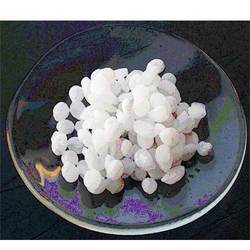

Sodium hydroxide (naoh), also known as lye and caustic soda, is a caustic metallic base. Sodium hydroxide forms a strong alkaline solution when dissolved in a solvent such as water. However, only the hydroxide ion is basic. It is used in many industries, mostly as a strong chemical base in the manufacture of pulp and paper, textiles, drinking water, soaps and detergents and as a drain cleaner. Worldwide production in 1998 was around 45 million tonnes. Sodium hydroxide is a common base in chemical laboratories. pure sodium hydroxide is a white solid, available in pellets, flakes, granules and as a 50% saturated solution. It is hygroscopic and readily absorbs water from the air, so it should be stored in an airtight container. It is very soluble in water with liberation of heat. It also dissolves in ethanol and methanol, though it exhibits lower solubility in these solvents than potassium hydroxide. It is insoluble in ether and other non-polar solvents. A sodium hydroxide solution will leave a yellow stain on fabric and paper. properties: 1. Molecular formula naoh 2. Molar mass 39. 9971 g/mol 3. Appearance white solid,hygroscopic 4. Density 2. 13 g/cm3 5. Melting point 323 °c, 596 k, 613 °f 6. Boiling point - 1388 °c, 1661 k, 2530 °f 7. Solubility in water 111 g/100 ml (20 °c) 8. Solubility in ethanol 13. 9 g/100 ml 9. Solubility in methanol 23. 8 g/100 ml .
Supplier of butyl alcohols, diethylene glycol, methyl alcohol, toxic methyl alcohol, bio butyl alcohol, branched chain butyl alcohol, organic diethylene glycol, laboratory diethylene glycol and branched chain butyl alcohol.
More details:View company website
Its Free
Verify Now